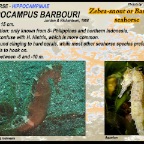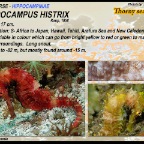Seahorse - Hippocampinae
The seahorse (Hippocampus) is probably the most unusual of all fishes. They swim in an upright position and have a long, strong tail which they use to hold themselves to plants or corals. The seahorse has a tube-like snout with a small mouth at the end. As they don’t have teeth, seahorses and pipefish suck-in their food. The length of the snout is variable and depends on their living environment and diet. They have a dorsal fin, two pectoral fins and some species also have an anal fin. All of the fins are soft-rayed. However the free-swimming species have the most developed fins. Most seahorse species live on or just above the substrate. Some of the pigmy seahorse species live in gorgonians, at depths below -20 m.
Length: 22 cm.Distribution: from Sulawesi and Moluccas in Indonesia to North-east Australia.Grey-brown to dark brown, females sometimes yellow. Inhabits shallow coastal waters, enters brackish water. Mostly found at depths between -5 and -12 m, but occasionally found at -20 m.Very similar to H. kuda. Length: 2 cm.Distribution: up till now only known from Sulawesi (Indonesia).White to yellow, pale face and belly. Distinctive red branching filaments on back and head. Gill opening behind coronet(crown). In pairs, on hydroids and coralline algae Halimeda, growing on vertical walls or larger boulders, from -11 to -25 m. This pygmy seahorse is discovered by a Indonesian dive guide who was killing time during a dive. Height: 16 cm.Distribution: propably restricted to the Moluccen Sea and N- Sulawesi, Indonesia.Very similar to H. taeniopterus but the coronet (small crown on the head) is mostlymore distinct. Variable in colour, from yellow to orange and purple-brown. White saddle in neck and whiteish areas towards dorsal fin. White striations on cheeck. On sand and muddy substrates of shallow protected bays, down to -20 m.
Length: 16 cm.Distribution: from the Izu region to China Sea and the Philippines.This seahorse has two cheek spines and is not brightly coloured. It has a long tale, with or without white bands. Lives on seagrass and soft bottom areas from around -1 m. down to -30 m. These photographs where made in less than one meter of water and the adult seahorse acted like it whas dead and did not move. Length: 15 cm.Distribution: from Japan, Philippines to Indonesia and the Coral sea.Very variable in colour which can go from bright yellow to red or green to matchtheir surroundings.To identify, you have to look for the spiny appearance and the long snout. Is mostly found at depths around -20 m. but occasionally found at shallower algae-rubble reef zones around -10 m. Length: 14 cm.Distribution: Mediterranean Seas, Black Sea and easter Atlantic.Primarily found in shallow inshore waters with algae, it probably floats along with drifting weeds. Colour variable to environment, black, brown or yellow.Mostly with many small white spots, these spots sometimes form fine lines on the trunk. Length: 15 cm.Distribution: East coast of the U.S.A, Gulf of Mexico to Florida and W- Indies.Can be found in a great variety of habitats, from shallow seagrass areas to deep waters of -70 m. Sometimes travelling with drifting sargassum weeds.Males can carry around 400 eggs. Length: 1,6 cm.Distribution: from S- Japan to Papua New Guinea, N- Australia and New Caledonia.Very similar to H. bargibanti but less humps on the body and no humps above orbetween the eyes. Colour goes from cream to orange-brown, humps always paler than body. Mostly found in Anella sp. or Acanthogorgia sp. gorgonias below -20 m.Humps are parts of coral that live symbiotically in the skin, a perfect camouflage. Height: 16 cm. Distribution: from the Andaman Sea to Vietnam, Philippines and Indonesia.Yellow, mostly with brown blotches, some males can be black with yellow blotches. Dark banded tail, and double cheek spines. Mostly found in pairs, on reefs with many soft coral. Usually below -20 m.Seeks for a safe place away from the substrate during night. Length: 2 cm.Distribution: West Pacific, Coral Sea, Australia, Indonesia to southern Japan. This very small and weird looking seahorse lives on coral of the Muricella spp. .Small parts of the coral live symbiotically in the skin of the seahorse and this reactsinto wards on head and body. This gives a perfect camouflage and matches colourand shape of it’s host. Can be found below -20 m. and as far as I know only found in shallower water at the Lembeh Strait (North-Sulawesi).Length: 15 cm.Distribution: only known from Philippines and northern Indonesia.Do not confuse with H. Histrix which does not have the stripes on the snout andthe coronet is less spiny. double cheek-spines and thick spine in front of the eyes.This species is often found clinging to hard corals which most seahorses don’t dobecause of the stingers. Found between -6 and -10 m. Length: 8,5 cm.Distribution: widespread in the Indo-West Pacific.Variable in colour. Long snout, male’s have broad blue-white margin in the wings.Common short-bodied species living in coastal waters. Adults usually found in pairs,on sand or mud bottoms. Mimicking items for camouflage. Expatriating to subtropical waters with pelagic young. Length: 5 cm.Distribution: W- Pacific, most reports come from Philippines and Indonesia.Variable in colour, from black and grey to brown, yellow and green. Females are very slim, males have more a seahorse look. Their skin attracts algae growth, thats why many have numerous hairy filaments on head and body. Usually found in pairs, holding on fine sea grass. On sandy bottoms with fine algae, coastal reefs, -1 to -20m.


























